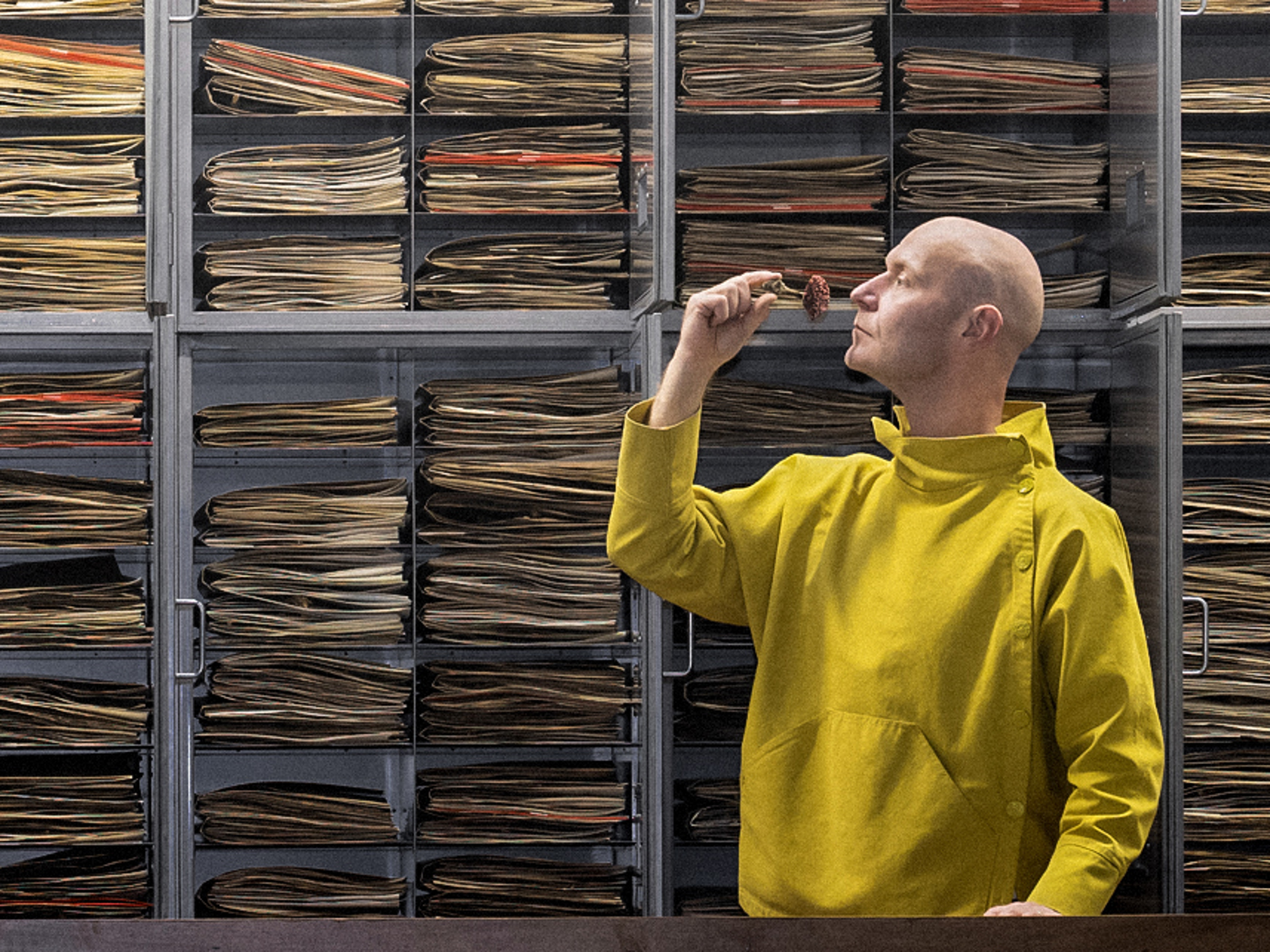How can we use odours to identify mushrooms? What can illustrations and descriptions of fungal odours in old books — and the odours of the books themselves — tell us about pasts smells? And how can artists offer a cultural context to mycological collections to help enrich our understanding of mushrooms?
These are some of the questions artist Dr Siôn Parkinson is asking as part his two-year project at the Royal Botanic Garden Edinburgh, which is titled ‘Fragrance in the Fungarium: A Creative Approach to the Olfactory Heritage of Mushrooms’. The project is funded by the Arts and Humanities Research Council (AHRC), part of UK Research and Innovation.
Siôn is one of eight researchers in the UK who have been awarded funding through a pilot scheme for Early Career Research Fellowships in Cultural and Heritage Institutions. The aim of the scheme — which is co-ordinated by the V&A — is to support post-doctoral researchers in taking up positions within independent research organisations (IROs) like the RBGE.
 Dr Siôn Parkinson, artist and AHRC Research Fellow, in the RBGE Herbarium. Image: RBGE, 2024.
Dr Siôn Parkinson, artist and AHRC Research Fellow, in the RBGE Herbarium. Image: RBGE, 2024.
Aims and objectives
The study aims to offer insights into the olfactory heritage of mushrooms — fungal smells that hold cultural or historical value for communities due to their association with significant places, objects, or traditions.
Siôn, who is based in RBGE’s Library and Archives team, is working with a range of mushroom-related material in our collections, including a rare copy of James Sowerby’s Coloured Figures of English Fungi (1797–1803). One of the objectives of the project is to reveal how old mushroom books and mycological artworks transform over time to reveal new tangible and intangible representations of fungal odours.
By offering a cultural context on mushrooms in libraries, archives, herbaria and in their natural habitats, this project will also support RBGE’s Strategic Objective to 'enrich and empower individuals and communities through learning and engagement with plants and fungi'.
 A fresh, 'foul-smelling' dune stinkhorn Phallus hadriani. Siôn is working with scientists and perfumers to capture the odour of this culturally significant mushroom. Image: Siôn Parkinson, 2024.
A fresh, 'foul-smelling' dune stinkhorn Phallus hadriani. Siôn is working with scientists and perfumers to capture the odour of this culturally significant mushroom. Image: Siôn Parkinson, 2024.
Project outputs
The project has three main expected outcomes:
- A ‘British Fungi: Odour Identification Guide’, a printed mushroom manual and olfactory toolkit developed in consultation with RBGE’s Science and Visitor teams, and created in collaboration with experimental scent designer Clara Weale.
- Three in-person workshops inviting audiences to explore the smell of mushrooms in museums, galleries and gardens. The project will also include two day-long workshops in Edinburgh aimed at the wider heritage sector, while also helping to establish and strengthen research networks with other artists and academics working in the emerging field of the Plant Humanities.
- A series of essays and artworks, including photography and drawings, which will inform the publication of a new book on the role of meaningful mushroom smells in libraries, archives and herbaria.
Project partners
Siôn has begun collaborating with curators and conservators at the KB National Library of the Netherlands to extract and analyse the odour of a rare sixteenth-century pamphlet about the smelly dune stinkhorn Phallus hadriani. Titled in English 'The Description of the Phallus' and published in 1564 by Dutch doctor Hadrianus Junius, this pamphlet is considered the first publication about a single mushroom species.

A rare copy of the sixteenth-century pamphlet 'Description of the Phallus' (1564) at the KB library, The Hague. Image: Siôn Parkinson, 2024.
Siôn is also working with Dr Cecilia Bembibre, an expert in molecular odour analysis at the Institute for Sustainable Heritage, University College London. Together, Siôn and Cecilia aim to identify the key chemical compounds that make up the dune stinkhorn’s powerful stench, which it uses to lure insects to help disperse its spores. Siôn's recreation of the stinkhorn scent will be used as part of an olfactory toolkit, allowing visitors to Scotland’s four Royal Gardens to experience one of the most significant smells in the history of mycology.


